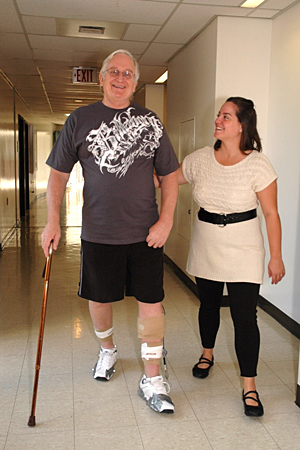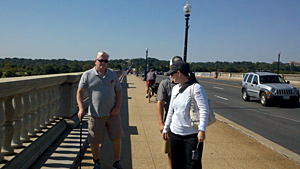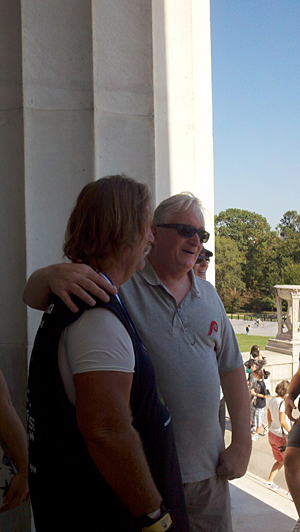ADVERTISEMENT
- Rozovsky wins prestigious NSF Early Career Award
- UD students meet alumni, experience 'closing bell' at NYSE
- Newark Police seek assistance in identifying suspects in robbery
- Rivlin says bipartisan budget action, stronger budget rules key to reversing debt
- Stink bugs shouldn't pose problem until late summer
- Gao to honor Placido Domingo in Washington performance
- Adopt-A-Highway project keeps Lewes road clean
- WVUD's Radiothon fundraiser runs April 1-10
- W.D. Snodgrass Symposium to honor Pulitzer winner
- New guide helps cancer patients manage symptoms
- UD in the News, March 25, 2011
- For the Record, March 25, 2011
- Public opinion expert discusses world views of U.S. in Global Agenda series
- Congressional delegation, dean laud Center for Community Research and Service program
- Center for Political Communication sets symposium on politics, entertainment
- Students work to raise funds, awareness of domestic violence
- Equestrian team wins regional championship in Western riding
- Markell, Harker stress importance of agriculture to Delaware's economy
- Carol A. Ammon MBA Case Competition winners announced
- Prof presents blood-clotting studies at Gordon Research Conference
- Sexual Assault Awareness Month events, programs announced
- Stay connected with Sea Grant, CEOE e-newsletter
- A message to UD regarding the tragedy in Japan
- More News >>
- March 31-May 14: REP stages Neil Simon's 'The Good Doctor'
- April 2: Newark plans annual 'wine and dine'
- April 5: Expert perspective on U.S. health care
- April 5: Comedian Ace Guillen to visit Scrounge
- April 6, May 4: School of Nursing sponsors research lecture series
- April 6-May 4: Confucius Institute presents Chinese Film Series on Wednesdays
- April 6: IPCC's Pachauri to discuss sustainable development in DENIN Dialogue Series
- April 7: 'WVUDstock' radiothon concert announced
- April 8: English Language Institute presents 'Arts in Translation'
- April 9: Green and Healthy Living Expo planned at The Bob
- April 9: Center for Political Communication to host Onion editor
- April 10: Alumni Easter Egg-stravaganza planned
- April 11: CDS session to focus on visual assistive technologies
- April 12: T.J. Stiles to speak at UDLA annual dinner
- April 15, 16: Annual UD push lawnmower tune-up scheduled
- April 15, 16: Master Players series presents iMusic 4, China Magpie
- April 15, 16: Delaware Symphony, UD chorus to perform Mahler work
- April 18: Former NFL Coach Bill Cowher featured in UD Speaks
- April 21-24: Sesame Street Live brings Elmo and friends to The Bob
- April 30: Save the date for Ag Day 2011 at UD
- April 30: Symposium to consider 'Frontiers at the Chemistry-Biology Interface'
- April 30-May 1: Relay for Life set at Delaware Field House
- May 4: Delaware Membrane Protein Symposium announced
- May 5: Northwestern University's Leon Keer to deliver Kerr lecture
- May 7: Women's volleyball team to host second annual Spring Fling
- Through May 3: SPPA announces speakers for 10th annual lecture series
- Through May 4: Global Agenda sees U.S. through others' eyes; World Bank president to speak
- Through May 4: 'Research on Race, Ethnicity, Culture' topic of series
- Through May 9: Black American Studies announces lecture series
- Through May 11: 'Challenges in Jewish Culture' lecture series announced
- Through May 11: Area Studies research featured in speaker series
- Through June 5: 'Andy Warhol: Behind the Camera' on view in Old College Gallery
- Through July 15: 'Bodyscapes' on view at Mechanical Hall Gallery
- More What's Happening >>
- UD calendar >>
- Middle States evaluation team on campus April 5
- Phipps named HR Liaison of the Quarter
- Senior wins iPad for participating in assessment study
- April 19: Procurement Services schedules information sessions
- UD Bookstore announces spring break hours
- HealthyU Wellness Program encourages employees to 'Step into Spring'
- April 8-29: Faculty roundtable series considers student engagement
- GRE is changing; learn more at April 15 info session
- April 30: UD Evening with Blue Rocks set for employees
- Morris Library to be open 24/7 during final exams
- More Campus FYI >>
10:27 a.m., Dec. 9, 2010----Glenn Woerner, who participated in a stroke study at the University of Delaware earlier this year, was so pleased with his improved mobility that he was inspired to join Mycle Brandy, four-time stroke survivor, at the finish of his Walk Across America on 10-10-10.
With a cane to support his right side, Brandy walked from his home in Orange County, Calif., to the nation's capital over an eight-month period to raise awareness about stroke and heart disease.
Woerner, who had a stroke in October 2007, walked the last leg of Brandy's trek with him in Washington, D.C., finishing on the steps of the Lincoln Memorial. He even received a mention on Brandy's website: “We were honored to have Glenn Woerner, fellow stroke survivor, who trained everyday on his treadmill, join me at the top of the steps.”
“I walked about a mile with Mycle,” Woerner says, “and until I finished, I wasn't sure I could walk that far. When you've had a stroke, you measure the world around you in terms of 'how far away is the bathroom and can I make it there?'”
Woerner says that his participation in the FastFES project in UD's Department of Physical Therapy increased his stamina and the distance he was able to cover. “I improved to a measurable degree during the program,” he says. “My day-to-day life is now much more active.”
Funded by the National Institute of Nursing Research of the National Institutes of Health and led by Stuart Binder-McLeod, professor and chair of the department, and Darcy Reisman, assistant professor of physical therapy, the FastFES study is examining the effect of treadmill training and functional electrical stimulation (FES) on daily function and quality of life in people with hemiparesis after stroke.
Woerner signed up for the study because he liked the idea that it was monitored and would impose a routine on his activity. “It's a pretty aggressive schedule, with three sessions a week for 12 weeks, which is way beyond what I was doing on my own,” he says.
Woerner was randomized into the group that walked fast on the treadmill and used FES to the lower leg muscles to facilitate walking. The other two groups walked, one at a comfortable pace and the other more rapidly, but did not receive the FES treatment.
“It was fascinating to see Glenn progress as I worked with him,” says physical therapist Tamara Wright. “Starting out, he heavily relied on his cane to walk, but towards the end of the study, he was able to walk more independently. It was evident that his confidence in his physical abilities had greatly improved, and I was really proud of his accomplishment in Washington.”
“Glenn started out walking at 0.9 mph on the treadmill and required his right hand on the handrail,” Wright continues. “By the end of the 12 weeks, he was walking at 1.7 mph and no longer had to fully rely on the handrail for support. He also more than doubled the distance he could walk in six minutes.”
Woerner is quick to downplay his own progress and accomplishments. “I may be the subject of a local human interest story, but the true hero is Mycle Brandy. His story is a real triumph of mind over body.”
The UD researchers, however, think Woerner also has a story worth telling.
“It takes a long time to get valid research results that tell us whether what we're doing is working on groups of people,” says Reisman. “In the meantime, it's really nice to get anecdotal evidence that we've helped individuals.”
Article by Diane Kukich





